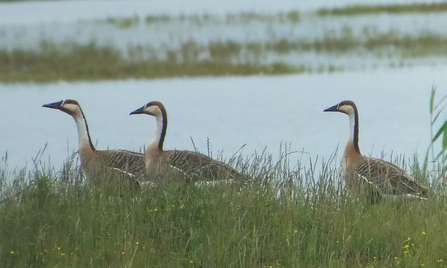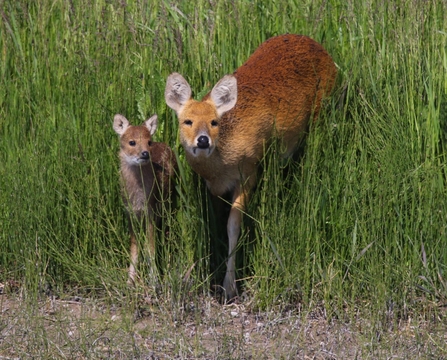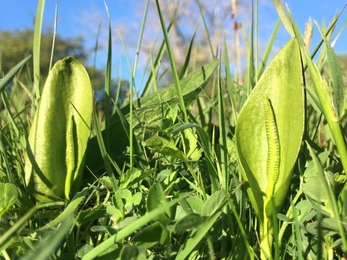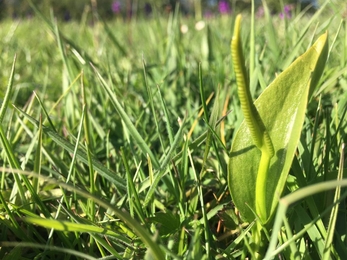Weekly wild news from our reserves, 12 June 2020
By Steve Aylward
During the summer months the distinctive purring of turtle doves can be heard at Black Bourn Valley nature reserve.
The turtle dove is a bit smaller than a collared dove; identifiable by its purring 'turrr turrr turr' song, compared to the familiar 'hoo hoooo-hoo' of the collared dove. Turtle doves are the UK's fastest declining bird species, largely due to agricultural intensification resulting in a lack of seeds, on which the birds depend.
Turtle dove at Black Bourn Valley (https://youtu.be/7sfLK_wxbO8)
Turtle dove at Black Bourn Valley
Black Bourn Valley is exceptional habitat for turtle dove for a variety of reasons. Once arable farmland, nature has been allowed to take over, and the reserve now has a brilliant extent of thick scrubby habitat, some of it over 50 years old. This thick, tall and wide scrub is essential for turtle dove success; nesting in amongst a tangle of hawthorn, blackthorn and bramble offers protection from predators and provides shade.
Turtle doves are granivores – solely seed eaters – moving around the outside of plants such as scarlet pimpernel and black medick to collect the seeds. Ideal feeding habitat for turtle doves is very specialised, being 30% vegetated ground and 70% bare ground. Cattle grazing at Black Bourn Valley provides this bare ground, as the cattle scuff areas around the ponds, pathways and ditch banks.
Black Bourn Valley also has a rich variety of freshwater ponds; 17 nationally and locally notable aquatic invertebrates have been identified as well as the nationally scarce tassell stonewort. These ponds are vital to turtle dove survival. The birds migrate from sub Saharan Africa each spring (over 5,000 miles!) and often arrive very dehydrated. Turtle doves also need water to produce ‘pigeon milk’ for their young; a regurgitated, milky substance from a food-storage organ called a 'crop'.
There are presently four turtle doves at Black Bourn Valley, which is a record and an indication of the excellent quality habitat given the specialism of species.
Adder’s tongues in Winks meadow
Adder’s tongue Ophioglossum vulgatum is a scarce fern, found on old grassland. Winks Meadow is rich in wildflowers, supporting a wide range of plants characteristic of ancient unimproved grassland, making it a special place in Suffolk.
The odd appearance of a fertile tongue-like frond partially enveloped by an oval-lanceolate ‘leaf’ is best seen from May-August when it releases spores.
In archaic days of sympathetic magic, it was believed to cure snake bite. Its later botanical family name Ophioglossum comes from Greek and means "snake-tongue".
Visitors from another land
Three 'swan goose' turned up on Peto’s Marsh on Sunday. These escapees are normally native to Siberia, Mongolia and northern China, but perhaps they feel at home surrounded by Chinese Water Deer that are found at Carlton Marshes.

Swan geese - Anser cygnoides - Andrew Easton
Fawns found at Carlton Marshes
In summer Chinese water deer have a lovely rust-red fur. This female and her fawn at Carlton Marshes, caught feeding on one of our camera traps, are easily distinguishable by their large teddy bear-like ears.
Chinese water deer on camera trap - Carlton Marshes (https://youtu.be/opJDmJqG0Ns)
Chinese water deer on camera trap - Carlton Marshes
Whilst surveying in the long grass at Carlton Marshes, Gavin Durrant stumbled across this very young Chinese Water deer fawn that hadn’t been born very long. Deer leave their young hiding in areas such as long grass and move away to feed in order to not draw unwanted attention from predators.
Young Chinese water deer Fawn at Carlton Marshes - Gavin Durrant (https://youtu.be/spWHcYvUNgY)
Young Chinese water deer Fawn at Carlton Marshes - Gavin Durrant
The female returns to feed the young periodically and when the fawn is strong enough to run from predators, it will start to accompany its mother on foraging trips, as shown here in Kevin Coote's picture of a female with her young.

Chinese water deer, Carlton Marshes - Kevin Coote



